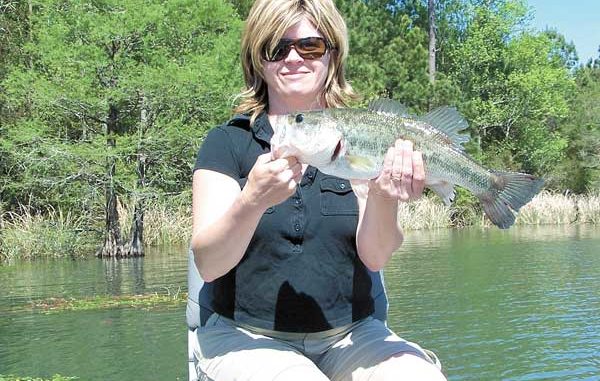
Lumber River offers great summertime bass fishing to anglers from both Carolinas.
Meandering through century-old cypress and tupelo swamps, the tea-colored waters of the picturesque Lumber River swiftly glide from its headwaters in the sandhills of North Carolina to its confluence with the Little Pee Dee River across the South Carolina line.
Paddlers and naturalists from across the region target the winding stretches of river for its primitive nature as a National Wild and Scenic River. Fishermen with a pressing drive for a small-craft, rod-bending adventure will quickly come to love the cypress branches, drooping under their Spanish moss coverings and extending over blackwater bends during the heat of the summer.
The extensive scenic reaches of wild river are home to a diverse population of fish, dominated by hand-sized redbreast sunfish and chunky “bucket mouths” — aka lunker largemouth bass.
As the 80-degree waters sizzle beginning in June, bass fishing becomes nothing less than explosive and extremely addictive for the avid fisherman. Although not widely known, the Lumber River fishery is prized by anglers throughout the region.
However, the terrain of the Lumber and other typical blackwater rivers come with a different playbook for landing trophy bass during the summer. Local knowledge and an understanding of blackwater river habitat both play important roles in success.
Each tree trunk or overhanging limb looks fishy to the casual fisherman seeing the Lumber for the first time; however, summertime bass frequently hold in specific places when water temperatures are more like a summer sauna.
“The fish (bass) are not scattered; they hold in discernable spots during the summer,” said Kent Brewer, a pro bass fisherman from North Carolina’s Robeson Co.. “Finding the perfect proportion of deep water, bottom composition, cover and current always produces the best results.
Raised along the sugary-white, sandy banks of the Lumber, Brewer has lipped many largemouth to his side over the past 40 years. He has dedicated his life to bass fishing, having substantial success; he’s won 127 of the 406 tournaments he’s entered.
In 2009, Brewer’s expertise got him one of 13 spots representing North Carolina on The Bass Federation’s state team, which is affiliated with FLW Outdoors. His best tournament win was a team event on North Carolina’s Shearon Harris Lake in March 2001 in which he and his partner weighed in a 10-fish limit at 80 pounds, four ounces.
Brewer has phenomenal knowledge of the largemouth bass in general, and exceptional skill in finding and landing big bass in eastern blackwater creeks and rivers, especially on his home water, the Lumber River.
Brewer concentrates his searches on areas that contain “special structure” — wooden structure in deep, slack water. While deep water is a relative term, bends in the Lumber during normal levels may hold eight to 12 feet of water.
Brewer’s favorite summertime spots are bends in the river that feature deep water with no current, but with shallow water immediately adjacent, plus a moderate current and woody cover. These areas will produce year after year as conditions permit. Oxbow lakes with deep holes, structure, and little current also provide good action during the summer.
“As the water temperature reaches its peak in the hottest periods of the summer, bass will also migrate towards areas within the very fastest runs,” Brewer said.
Blackwater systems’ fish and forage communities differ significantly from typical river systems. For instance, blackwater systems have elevated acid levels. Animal and plant plankton production, important to juvenile fish, is very limited. In this case, juvenile fish depend heavily on terrestrial insects and worms.
Largemouth bass in the river have a diverse diet, with small fish included in the daily menu, but the river is home to many species of amphibians, reptiles, and insects that play major roles in the battle between fisherman and bass. The eastern swamps annually produce bumper crops of energy-rich forage, which contributes to the chunky nature of the bass’s physique. Lunker largemouth lurk beneath the surface film, scanning their territory for the silhouette of a frog, grasshopper, or small baitfish dabbling in the shallows early in the morning and late in the afternoon. That will initiate the daily topwater feeding frenzies prized by anxious fishermen.
“Buzzbaits and frog imitations are deadly for summertime bass on the Lumber,” says veteran fisherman Jamie McCallum of Dillon, S.C.
Raised on the Little Pee Dee and Lumber Rivers, McCallum always counts on an explosive strike every few casts during a summer excursion. His techniques revolve around extremely low-water periods, and he relies strictly on a topwater presentation early and late in the day. He prefers Zoom Horny Toads in various colors, and buzzbaits in white, chartreuse, blue, or black.
“When you start seeing large, white sandbars forming in the middle, and wide sandy beaches appearing on the edges, conditions are perfect for fantastic topwater fishing. The bass cannot stand watching a topwater lure sloshing across the surface,” McCallum said.
Just as Brewer does, McCallum concentrates his search efforts within the deep bends of the river with abundant woody cover. And he always schedules a string of summer fishing trips on the Little Pee Dee or Lumber during the hottest and driest days of the summer.
“Bass in the river feed heavily on prey species at or near the surface during the summer, and topwater lures produce hot action early and late in the day during the summer pattern,” Brewer said
Brewer starts and finishes his trips with long, slender lures such as: Cotton Cordell Boy Howdy (silver or gold) or a No. 13 Rapala topwater jerkbait (silver or gold). A 3/8-ounce double buzzbait (white or chartreuse) also produces explosive strikes. Brewer casts to the edges of pools and retrieves parallel down the bank as close to the cover as possible. Parallel casts keep the lure in the strike zone longer increasing his chances for strikes.
“Lightly lay your offerings,” said Brewer, who loves to get a topwater bait on the surface with as little disturbance as possible. Fish will sometimes spook when a lure causes too much commotion as it lands on the water, he said.
As the sun climbs above the treeline, Brewer switches gears and goes sub-surface, casting a 9- or 10-inch worm Texas-rigged with a pegged quarter-ounce sinker in dark colors such as scuppernong, black or grape. At times, a floating worm or wacky-rigged Senko in any bright color (lime, white, or sherbet) cast into slack areas can be productive as well.
While location and lure choice are important, water levels are critical for the best river fishing. Brewer says the best fishing is during periods of low water — even during a drought.
“Their hangouts are much more clearly visable, and the deep bends become a real premium,” he said.
However, when normal water conditions exist, any fluctuating water will increase feeding activity. Summer storms frequently unload several inches of rain within the river’s watershed, causing water levels to surge and precipitate a feeding frenzy, but bass will also feed well on a slow rise.
The best locations on the Lumber River are not too specific other than deep bends, slack water, and abundant structure. Brewer fishes from the Pembroke Area to its confluence with the Little Pee Dee.
“One stretch is not much different from the other, and the entire river holds bass, but I concentrate on reaches with numerous bends,” said Brewer, who does prefer to fish in areas away from municipalities and protected by surrounding wilderness. Fishing pressure is less in these areas, and the fishing is better.
Beyond its aesthetic beauty, the Lumber River has played a vital role in American history. From fueling the timber and naval stores industry of the 18th century, to providing picturesque canoe trails with a National Wild and Scenic River, the Lumber River is a destination for Carolina anglers for targeting trophy largemouth bass.

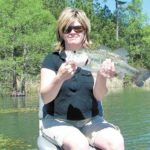
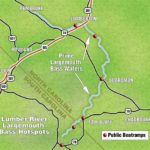
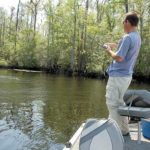

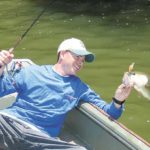
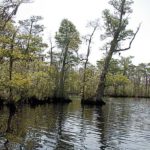



Be the first to comment